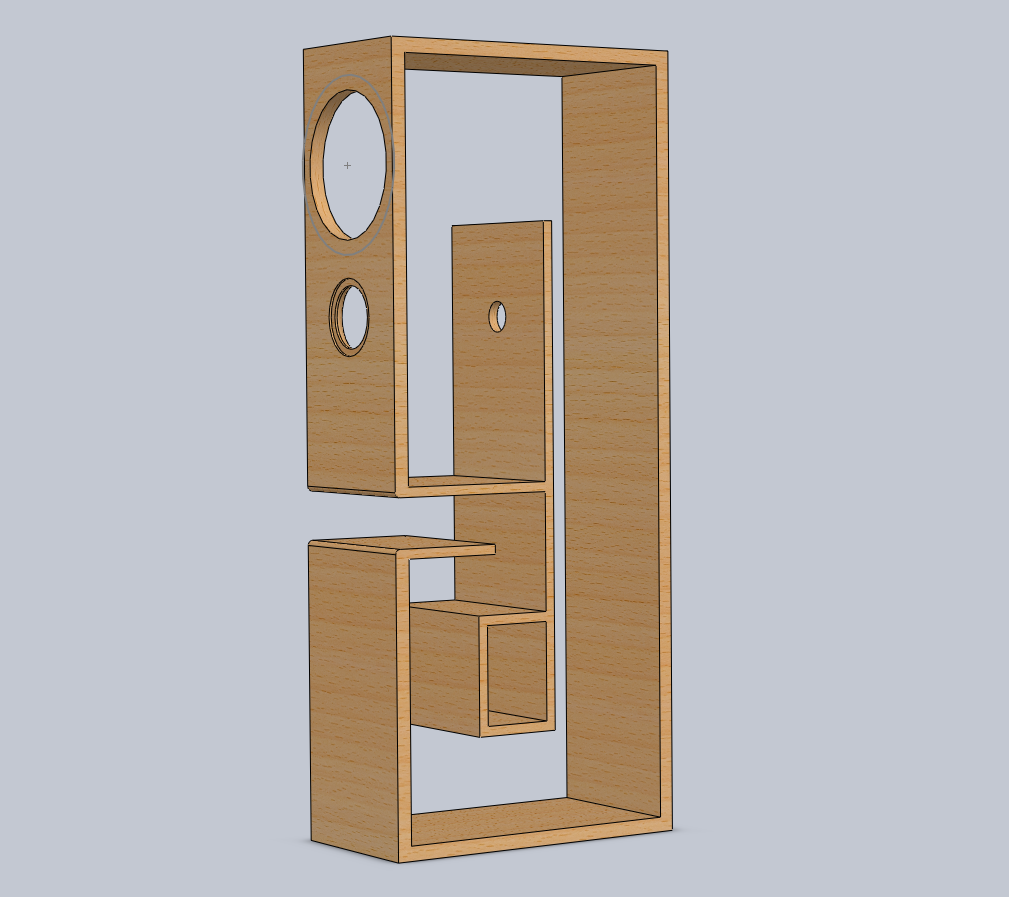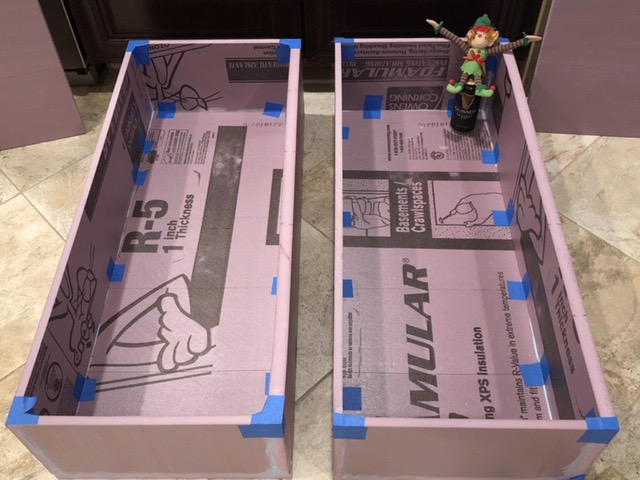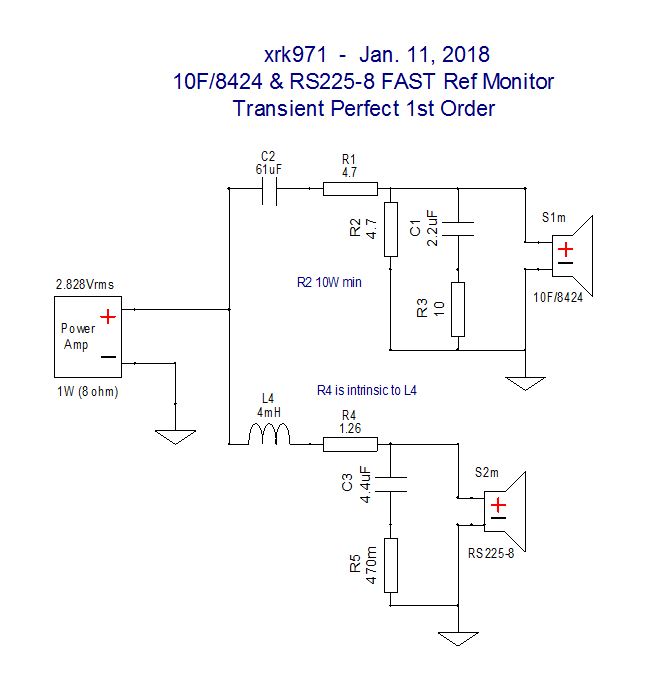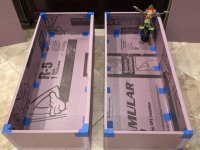GB Status Update
Thank you, Webber. 🙂
That’s 18 boards so far, I think Vunce needs 2 because he is building the TL speaker tomorrow.
Name Quantity Boards Country
xrk971 8 USA
Jwjarch 2 USA
Ray21 2 USA
mordikai 4 USA
Webber 2 USA
Thank you, Webber. 🙂
That’s 18 boards so far, I think Vunce needs 2 because he is building the TL speaker tomorrow.
In case you guys haven’t seen it, here are the plans for a floorstanding tapered (PMC-style) TL version of this speaker.

Reaches down to 30Hz with similar efficiency as rest of bandwidth.

More info here:
10F/8424 & RS225-8 FAST / WAW Ref Monitor
Vunce is leading the pathfinder to prototype in XPS foam.
Reaches down to 30Hz with similar efficiency as rest of bandwidth.
More info here:
10F/8424 & RS225-8 FAST / WAW Ref Monitor
Vunce is leading the pathfinder to prototype in XPS foam.
GB Status:
Thanks, Drpro.
Name Quantity Boards Country
xrk971 8 USA
Jwjarch 2 USA
Ray21 2 USA
mordikai 4 USA
Webber 2 USA
Drpro 2 USA
Thanks, Drpro.
Vunce’s XPS foam adventure has begun:

Those are serious pieces of speaker size wise!
Those are serious pieces of speaker size wise!
Attachments
Last edited:
GB Pre-orders can be placed here:
Transient Perfect Crossover PCB for 10F/RS225 FAST Speaker | Etsy
Thanks!
Transient Perfect Crossover PCB for 10F/RS225 FAST Speaker | Etsy
Thanks!
GB Status Update:
Thank you, Webber!
Name Quantity Boards Country
xrk971 8 USA
Jwjarch 2 USA
Ray21 2 USA
mordikai 4 USA
Webber 2 USA *Pre-Order Placed*
Drpro 2 USA
Thank you, Webber!
Hi X,
Thanks for all the info on working with XPS. 2" XPS may be a bit bulky looking on certain projects, so I will have to experiment with sizes and techniques.
On a side note: You know I am a fan of all the work your group does to promote audio boards and ideas that make our lives easier, when it comes to building audio projects, as I have bought many of your pcb's. I realize that you need to be compensated for the work you do. I have looked at all the prices that you have charged for various pcb boards, and I am wondering how the simplest board you have possibly manufactured (the X-over board), is going to be one of the most expensive I may purchase from you (approx. $70 CDN each delivered x 2 = $140 CDN without components). If I am missing something, or if there is some part of manufacturing that costs more in the case of the X-over, please let me know. Please understand I am not bitching / complaining, just curious on pricing.
Thanks for the consideration in this matter,
Myles
Thanks for all the info on working with XPS. 2" XPS may be a bit bulky looking on certain projects, so I will have to experiment with sizes and techniques.
On a side note: You know I am a fan of all the work your group does to promote audio boards and ideas that make our lives easier, when it comes to building audio projects, as I have bought many of your pcb's. I realize that you need to be compensated for the work you do. I have looked at all the prices that you have charged for various pcb boards, and I am wondering how the simplest board you have possibly manufactured (the X-over board), is going to be one of the most expensive I may purchase from you (approx. $70 CDN each delivered x 2 = $140 CDN without components). If I am missing something, or if there is some part of manufacturing that costs more in the case of the X-over, please let me know. Please understand I am not bitching / complaining, just curious on pricing.
Thanks for the consideration in this matter,
Myles
Hi Kokanee,
It breaks the 100mm x 100mm barrier and the manufacturing price takes a big jump. It’s also 2mm thick (upgrade from 1.6mm), has double thick 2oz copper traces, and has gold ENIG finish. Basically every premium option thrown in.
There is another point where the price skyrockets - board’s larger than 250mm in any dimension.
The base pricing is for 100mm square and under and 1.6mm thick and HASL lead finish, and no gold plating.
For the Alpha Nirvana amp, for example, although that board was under 100mm square, it has two tiny snubber boards that go with it. The little pair of snubber boards cost as much as the main amp board which is much bigger. Fortunately, they don’t charge for complexity. That’s how we can have 2000vias and it costs no more. Why because the price is based on the 100mm size again. Below that size no matter how small, there’s is a minimum cost.
Hope that helps explain things.
Cheers,
X
It breaks the 100mm x 100mm barrier and the manufacturing price takes a big jump. It’s also 2mm thick (upgrade from 1.6mm), has double thick 2oz copper traces, and has gold ENIG finish. Basically every premium option thrown in.
There is another point where the price skyrockets - board’s larger than 250mm in any dimension.
The base pricing is for 100mm square and under and 1.6mm thick and HASL lead finish, and no gold plating.
For the Alpha Nirvana amp, for example, although that board was under 100mm square, it has two tiny snubber boards that go with it. The little pair of snubber boards cost as much as the main amp board which is much bigger. Fortunately, they don’t charge for complexity. That’s how we can have 2000vias and it costs no more. Why because the price is based on the 100mm size again. Below that size no matter how small, there’s is a minimum cost.
Hope that helps explain things.
Cheers,
X
Last edited:
Thanks X,
I thought that might be the case. I will have to think about whether to buy or to breadboard a XO myself.
Are you planning to keep some inventory of these on your Etsy website for those people that may want to order in the future, or is it the pre-order or nothing scenario.
Myles
I thought that might be the case. I will have to think about whether to buy or to breadboard a XO myself.
Are you planning to keep some inventory of these on your Etsy website for those people that may want to order in the future, or is it the pre-order or nothing scenario.
Myles
Hi Folks,
For those of you who have not placed your pre-orders, please do so at your earliest convenience so that we can get the manufactiring kicked off.
Thanks,
X
For those of you who have not placed your pre-orders, please do so at your earliest convenience so that we can get the manufactiring kicked off.
Thanks,
X
Name Quantity Boards Country
xrk971 8 USA
Jwjarch 2 USA
Ray21 2 USA
mordikai 4 USA
Webber 2 USA *Pre-Order Placed*
Drpro 2 USA
These days I am improving the crossover of my little coaxials. The changes I have made are greatly appreciated, hence I strongly recommend them for the tweeter.
Bypassing C2 with a Miflex KPCU-01 0.022uF 600Vdc. And changing R1 with Mills MRA 12 watts.

First only one speaker, so you can compare with the second without modifying, changing the channels. Remember, a good recording! With acoustic and/or electrified instruments the difference is amazing, at least in my loudspeakers.
* Audiocircle: Re: Looking for a new pair of 0.22uf coupling caps.
* Audiocircle: Resistors with very low inductance -> speaker crossover and in others places
Bypassing C2 with a Miflex KPCU-01 0.022uF 600Vdc. And changing R1 with Mills MRA 12 watts.
An externally hosted image should be here but it was not working when we last tested it.
First only one speaker, so you can compare with the second without modifying, changing the channels. Remember, a good recording! With acoustic and/or electrified instruments the difference is amazing, at least in my loudspeakers.
* Audiocircle: Re: Looking for a new pair of 0.22uf coupling caps.
* Audiocircle: Resistors with very low inductance -> speaker crossover and in others places
Last edited:
I am sorry, I should have posted in the other thread, 10F/8424 & RS225-8 FAST / WAW Ref Monitor
Now I can not edit or delete. Maybe an admin...
Now I can not edit or delete. Maybe an admin...
Last edited:
Hi Maty,
Thus would be close to a $45 experiment with shipping. Hmmm...
Miflex KPCU 0.022uF 600VDC Copper foil Poly/Paper in Oil, Sonic Craft
Copper foil in paper/polypropylene and oil.
Have you heard of Rifa foil/paper caps? I have some of these and want to try them too.
PME261JB5220KR30 KEMET | Capacitors | DigiKey
But what I really want to try are some polycarbonate caps that I have. They have made a noticeable difference as front end coupling caps on my Aksa amps vs MKP.
Thus would be close to a $45 experiment with shipping. Hmmm...
Miflex KPCU 0.022uF 600VDC Copper foil Poly/Paper in Oil, Sonic Craft
Copper foil in paper/polypropylene and oil.
Have you heard of Rifa foil/paper caps? I have some of these and want to try them too.
PME261JB5220KR30 KEMET | Capacitors | DigiKey
But what I really want to try are some polycarbonate caps that I have. They have made a noticeable difference as front end coupling caps on my Aksa amps vs MKP.
I was very reluctant, because I did not understand and I still do not understand why it works. That is why I tried first with some cheap NOS styroflex, but only I could appreciate the difference (we are always same two to evaluate). With the Miflex bypass cap the improvement was spectacular, amazing, between the two loudspeakers, let us not say when playing both Hotel California (Eagles)!!!
Almost the same with Mills MRA resistors. It is assumed that Bennic's ceramic has very little inductance.
I have read explanations but I can hardly believe that they cause such a sound difference. Maybe the original M.D.L. capacitor and Bennic resistor are very bad? no idea.
Almost the same with Mills MRA resistors. It is assumed that Bennic's ceramic has very little inductance.
I have read explanations but I can hardly believe that they cause such a sound difference. Maybe the original M.D.L. capacitor and Bennic resistor are very bad? no idea.
Last edited:
Tony Gee likes the Cornell Dubilier 940C / 0,01uF / 3000VDC - 10% tolerance
Humble Homemade Hifi - Cap Test
Humble Homemade Hifi - Cap Test
...Sound: Using the 3000VDC Cornell Dubilier 940C as a bypass capacitor in the value 0,01uF really is the "icing on the cake" when you are looking for a low cost bypass capacitor that gell's everything into one coherent sound. Over the past few years I have used these in many different combinations and everytime they just added more to the overall sound. More coherency and more ease. Especially when you have been "cooking" to find your favourite mix of capacitors and only need to cement the different characters together. Adding the 940C creates an overall more mature sounding speaker. And no, they are not better than the Duelund Silver Bypass capacitor that excel's in naturalness and richness of tone. The Duelund is in another league, not only in sound quality but also in price ;-) The Vishay MKP1837 used to be my favourite low cost bypass capacitor but now it is the Cornell Dubilier 940C / 0,01uF / 3000VDC. It surpasses the Vishay with quite some margin 🙂
Verdict: use them everywhere!
Last edited:
Hi Maty,
You might try KOA Speer BPR series power resistors. They have essentially zero inductance as they are made from a cut plate of metal (no windiings of any sort or spiral cut metal thin film etc). I have measured a reduction of harmonic distortion vs even the venerable Panasonic ERX series resistors, which were my previous favorites.
http://www.koaspeer.com/catimages/Products/BPR/BPR.pdf
I have not seen anyone use these for XO's, but why not? They are 5W, so to get 10W, use half the value in series. They are not expensive either and take up little room on a PCB.
I'll have to check out the Mills resistors. Maybe they would work well as amplifier MOSFET source or BJT emitter resistors as well.
You might try KOA Speer BPR series power resistors. They have essentially zero inductance as they are made from a cut plate of metal (no windiings of any sort or spiral cut metal thin film etc). I have measured a reduction of harmonic distortion vs even the venerable Panasonic ERX series resistors, which were my previous favorites.
http://www.koaspeer.com/catimages/Products/BPR/BPR.pdf
I have not seen anyone use these for XO's, but why not? They are 5W, so to get 10W, use half the value in series. They are not expensive either and take up little room on a PCB.
I'll have to check out the Mills resistors. Maybe they would work well as amplifier MOSFET source or BJT emitter resistors as well.
Last edited:
- Home
- Group Buys
- 10F/RS225 FAST / WAW Speaker XO PCB GB
